
The Curtis Memorial Library, now the Augusta Curtis Cultural Center, is a historic former library building at 175 East Main Street in Meriden, Connecticut. It was designed by New Haven architect Richard Williams in the Classical Revival style, and was completed in 1903. The building was a gift to the city from Augusta Munson Curtis in honor of her husband George, who was one of the city's leading businessmen and onetime mayor. It was listed on the National Register of Historic Places in 1981.

The Kentucky Historical Society (KHS) is an agency of the Kentucky state government that records and preserves important historical documents, buildings, and artifacts of Kentucky's past. It was originally established in 1836 as a private organization. The KHS history campus, located in downtown Frankfort, Kentucky, includes the Thomas D. Clark Center for Kentucky History, the Old State Capitol, and the Kentucky Military History Museum at the State Arsenal. KHS is a part of the Kentucky Tourism-Arts and Heritage Cabinet, is fully accredited by the American Alliance of Museums, is a Smithsonian affiliate, and endorses the History Relevance statement. The mission of the KHS is to educate and engage the public through Kentucky's history in order to confront the challenges of the future. The KHS allows the public access to their resources through the online Library catalog along with the in-person Library.

The Sycamore Historic District is a meandering area encompassing 99 acres (400,000 m2) of the land in and around the downtown of the DeKalb County, Illinois county seat, Sycamore. The area includes historic buildings and a number of historical and Victorian homes. Some significant structures are among those located within the Historic District including the DeKalb County Courthouse and the Sycamore Public Library. The district has been listed on the National Register of Historic Places since May 2, 1978.

The Santa Barbara County Courthouse (Courthouse) is a well-known example of Spanish Colonial Revival architecture and is located in Santa Barbara, Santa Barbara County, California. Started in 1926 and completed in 1929, the Courthouse originally served as Santa Barbara County’s (County) superior courthouse, jail, and administrative office. The Courthouse was included on the National Register of Historic Places in 1981, was made a City of Santa Barbara Historic Landmark in 1982, a California Historical Landmark in 2004, and a National Historic Landmark in 2005. Over the years, most County administrative offices were relocated to other County buildings. The current Courthouse houses six County Superior Court rooms, the Mural Room, the County Hall of Records, the County Public Defender's Office, offices of the County General Services Department, and the McMahon Law Library. The Courthouse is open to the public and is a popular site for community gatherings and weddings. Architect Charles Willard Moore called it the "grandest Spanish Colonial Revival structure ever built," and the prime example of Santa Barbara's adoption of Spanish Colonial as its civic style.
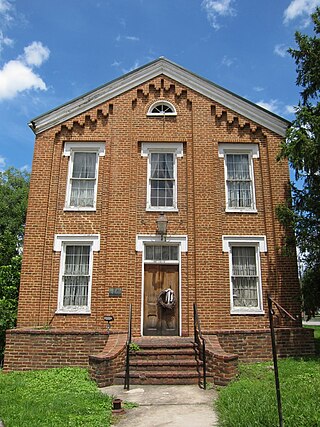
Literary Hall is a mid-19th-century brick library, building and museum located in Romney, a city in the U.S. state of West Virginia. It is located at the intersection of North High Street and West Main Street. Literary Hall was constructed between 1869 and 1870 by the Romney Literary Society.

The Goffstown Public Library is located at 2 High Street in Goffstown, New Hampshire. The building it occupies was designed by architects Henry M. Francis & Sons and was built in 1909. It is small Classical Revival building built of brick with stone trim, and was added to the National Register of Historic Places in 1995. It is one of the finest examples of Classical Revival architecture in the town, with a three-bay main facade whose central entrance projects slightly, and is topped by a pediment supported by Ionic columns.

The Chapel of the Holy Cross is a historic church at 45 Chapel Lane on the campus of Holderness School in Holderness, New Hampshire. Built in 1884 to a design by Charles Coolidge Haight, it is a prominent regional example of Gothic Revival architecture. The building was listed on the National Register of Historic Places in 2005.

Chester Congregational Church is a historic church at 4 Chester Street in Chester, New Hampshire. This wood-frame building was originally built as a traditional New England colonial meeting house in 1773, and underwent significant alteration in 1840, giving it its present Greek Revival appearance. It was listed on the National Register of Historic Places in 1986.
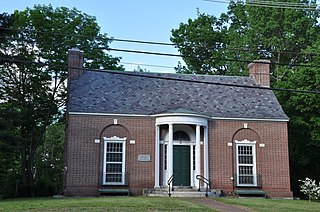
The Boscawen Public Library is the public library of Boscawen, New Hampshire, United States. It is located at 116 North Main Street. The library's first building, built in 1913 to a Colonial Revival design by Guy Lowell, was listed on the National Register of Historic Places in 1981, and is slowly undergoing rehabilitation.
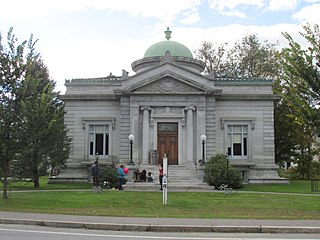
The Shedd-Porter Memorial Library, located at 3 Main Street, is the public library of Alstead, New Hampshire. The library building was a gift to the town from John Graves Shedd and Mary Roenna (Porter) Shedd, and is a Beaux Arts building built in 1910 to a design by William H. McLean and Albert H. Wright. Shedd also donated 2,000 books to the library, whose collection now exceeds 10,000 volumes. The library building, one of the finest of the period in the state, was listed on the National Register of Historic Places in 2010, and the New Hampshire State Register of Historic Places in 2011.

The Holderness Free Library is the public library of Holderness, New Hampshire. It is located at 866 US Route 3, at its junction with New Hampshire Route 113. The architecturally eclectic building it presently occupies was built in 1909 to a design by Boston architects Fox & Gale, and was listed on the National Register of Historic Places in 1985. It was the first purpose-built building for the library, which had occupied private homes and other facilities since its founding in 1893.

The Cook Memorial Library is the public library of Tamworth, New Hampshire, United States. It is located at 93 Main Street in the center of the town, in an 1895 Queen Anne Victorian building which is listed on the National Register of Historic Places. The library's origins are in a private "social library" established in 1796 by Parson Samuel Hidden; the building was given in memory of Charles Cook, a prominent local businessman and politician.

The Victory Park Historic District of Manchester, New Hampshire, encompasses Victory Park, a city park laid out in 1838, and four buildings that face it across adjacent streets. Originally called Concord Square, Victory Park was laid out by the proprietors of the Amoskeag Manufacturing Company who founded Manchester, and was first used as a common area, used by abutters for gardening and grazing. The park was sold by the proprietors to the city for $1 in 1848, conditioned on making alterations that would transform it into a park. The city did not immediately act on the required conditions, but it had by the 1870s become more parklike, with a fountain and thickly-planted trees. The park was renamed after the First World War; its most prominent feature is the Winged Victory Monument to the city's soldiers in that war, designed by Lucien Hippolyte Gosselin and erected in 1929. The park underwent a major rehabilitation in 1988.

The Wilton Public and Gregg Free Library is the public library of Wilton, New Hampshire. It is located in a Classical Revival brick building on Forest Street, near the north end of Wilton's downtown area. The building was designed by the Boston, Massachusetts, firm of McLean & Wright, and built 1905-07. It was a gift of David Almus Gregg, a local manufacturer of building parts; Gregg further gave the library an endowment in 1912. It was listed on the National Register of Historic Places in 1982.
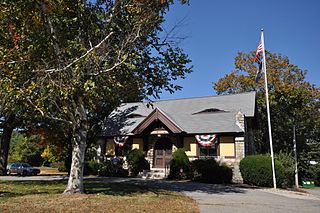
The Old North Hampton Library is a historic library building at 237 Atlantic Avenue in North Hampton, New Hampshire. The small, single-story Tudor Revival structure was designed by Boston architect J. Lawrence Berry and built in 1907. It was the town's first purpose-built library building, and was used as such until a new library was built nearby in 1973. It presently houses town offices. The building was listed on the National Register of Historic Places in 2014, and the New Hampshire State Register of Historic Places in 2013.
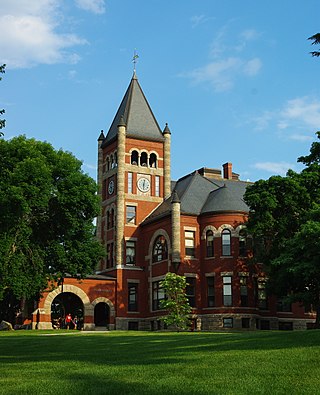
Thompson Hall, commonly referred to locally as "T-Hall", is one of the central buildings on the campus of the University of New Hampshire in Durham, New Hampshire, United States. A large brick and stone building, it was designed by Concord architects Dow & Randlett and built in 1892. It was the first building to be built on the Durham campus, and was named for Benjamin Thompson, a farmer who left his entire Durham estate to the state for use as the college campus. The building was listed on the National Register of Historic Places in 1996.
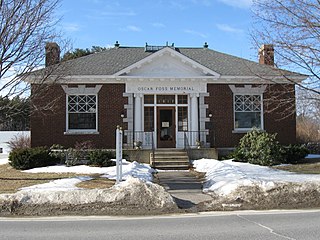
The Oscar Foss Memorial Library is the public library of Barnstead, New Hampshire. It is located in the center of town at 111 South Barnstead Road, in a single-story Colonial Revival building designed by the William M. Butterfield Company of Manchester and built in 1916-17. The library was a gift of Sarah Foss in memory of her husband Oscar, a prominent local businessman who died in 1913.

The Gilmanton Ironworks Library is a historic library building at 10 Elm Street in the Iron Works village of Gilmanton, New Hampshire. Built in 1916–17, it was the first Colonial Revival library building in Belknap County. The building, still serving as a branch of the Gilmanton public library system, was listed on the National Register of Historic Places in 1989.

The Meredith Public Library is located at 91 Main Street in Meredith, New Hampshire. It is housed in a handsome brick Classical Revival structure designed by George Swan and built in 1900–01, with a major expansion in 1985. It was a gift from Benjamin Smith as a memorial to his parents, and is known as the Benjamin M. Smith Memorial Library. The building, one of the town's most architecturally sophisticated buildings, was listed on the National Register of Historic Places in 1984.
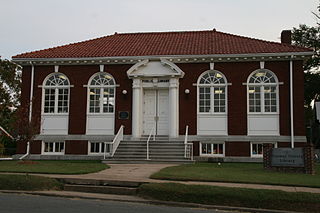
The Conway County Library is the public library system of Conway County, Arkansas. The main library is located at 101 West Church Street in downtown Morrilton, Arkansas, the county seat. The library is located in a Classical Revival brick building designed by Thomas Harding and funded in part by a grant from Andrew Carnegie. In 1916 the Pathfinder Club of Morrilton applied for the grant. A lot was purchased, and Morrilton Mayor J. A. Frisby, Night Rainwater, and W. M. Riddick worked with a committee to construct the new library. The construction cost was $7,500, leaving $2,500 to purchase coal and furniture for the building. The building was completed in October 1916 and still serves as the Conway County Library. The building was listed on the National Register of Historic Places in 1978. The library organization began as a private collection in 1894, and was housed in private residences and vacant commercial buildings prior to the construction of this building.























